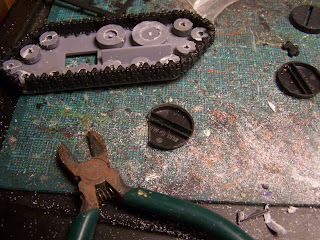
After a couple of test games with my version 1 army, I came to some conclusions:
-The basilisk, which was originally a filler unit, is really good and I'm keeping it. Dropping cover-ignoring AP3 shots on top of guys anywhere on the board, whether you can see them or not, is really tactically invaluable.
I had to make some modifications to my old basilisk model. The paint job is from my Iron Warriors army of 2001 (back when Iron Warriors could take a basilisk in 3rd edition). So I pulled off the chaos trophy racks and the servitor crewman and am in the process of sticking on imperial gubbins before the new paint job.
-The 30-man blob plus everybody else is a vehicle works really well. Hybrid mech. The blob protects the vehicles from things they're vulnerable to, and the vehicles do the killing that the blob can't.
-Although I was originally against heavy weapons in the blob--because I figured they'd be moving a lot--if you crunch the numbers you find that putting 3 heavy weapons in 3 infantry squads is cheaper than an additional heavy weapon squad for the same number of guns. Because you don't have to make the outlay for the HWS, you can pack more heavy guns into the army by filling up your infantry squads first, then buying more weapons for heavy weapon squads with additional points. Also, if the 3 infantry squads are blobbed and have heavy weapons, you can give them "bring it down" and "fire on my target" orders on the commissar's leadership of 9.
So with these insights in mind, here's the list I plan to play in the Game Castle Summer league starting tonight:
- CCS, 3 meltaguns, in a chimera with hull heavy flamer
- Infantry Platoon
-PCS, 3 flamers in a chimera, hull heavy flamer
-3 infantry squads with autocannons, one with a commissar, sergeants with power weapons and meltabombs
-Autocannon heavy weapon squad
-Missile launcher heavy weapon squad - Vet squad, 3 meltas, in a chimera
(not happy with this choice, but I need a second troop) - Devil Dog, dozer blade, hull heavy flamer
- Devil Dog, hull heavy flamer
- 2 Hydras, hull HF
- Basilisk, hull HF
- Leman Russ BT, hull HF
6 infantry autocannons
4 hydra autocannons
3 missile launchers
6 infantry meltas
2 melta cannons
3 infantry flamers
3 multilasers
Battle Cannon
Earthshaker Cannon
9 hull-mounted heavy flamers





































